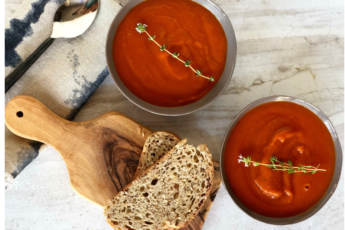Grain foods and starchy veggies like potatoes are often used interchangeably in meals, so the 2025-2030 Dietary Guidelines Advisory Committee (DGAC) is asking if they should develop dietary guidelines based on how people use these 2 foods? (Uh, nevermind nutrition?).
They asked for comments, and yes, I had plenty to say – in the 2 minutes allotted) on September 12, 2023, when I provided oral comments (I surface at exactly 43:30 into things).
What’s My Gripe? Read On…
People often use grain foods and starchy vegetables interchangeable for CULINARY purposes, i.e. preparing meals, but nutritionally these foods are quite different and should be considered differently when developing nutritional recommendations and policies like the US Dietary Guidelines for Americans (DGA).
Grain foods like rice, bread, and pasta, have different nutrient profiles than starchy vegetables, like potatoes and winter squash! Each makes a nutritional contribution, but a different one.
 Menu Modeling: Evidence for The Difference
Menu Modeling: Evidence for The Difference
I authored this recently published perspective in the journal Frontiers In Nutrition that demonstrated the nutritional differences that can result when potatoes are replaced with grain foods. I took a “foundational menu”, that aligns with USDA’s “Food Pattern and the 2020–2025 DGA, that included both potato and grain foods (hash browns, baked potato, bread, corn flakes, etc. and replaced all the potato foods with grain alternatives (an extra slice of bread for the hash browns, swapping rice for the baked potato).
Here’s how the all-grain, no-potato diet differed:
• Potassium and dietary fiber: DECLINED by 21% and 10%, respectively.
• Vitamin C: DECLINED 11%
• Vitamin B6: DECLINED 17%
• Sodium: DECLINED by 12%
The above represent the nutrient variances of at least 10%. There were smaller declines for vitamin E and choline, important antioxidants. The all-grain, no-potato diet showed minor increases of some nutrients but none reached the 10% benchmark.
Why Is This Troubling Me?
Potassium and dietary fiber are 2 “nutrients of concern”, so named because over 50% of the population isn’t getting enough of either. So, the reduction in potassium and dietary fiber with the all-grain, no-potato diet could be worrisome.
Potatoes & Vitamin C? You probably don’t think of potatoes as a source of vitamin C. They are – a medium-sized baked potato has 30% of the Daily Value of vitamin C!
Potatoes & potassium? You might associate potassium with bananas, but a medium-sized baked potato has MORE potassium than a large banana! Grains? They have other nutrients, but not potassium or vitamin C. This is only one reason these food categories are not interchangeable.

Photo: pixabay.com
Got Culture & Diversity?
Starchy vegetables like white and sweet potatoes feature strongly in almost every cuisine. Makes sense, as they’re easy to grow in many types of soil year around. You may not think of Asian cuisine as using potatoes but it does (check this stir-fry recipe from Bon Apetit, for further explanation). China produces more potatoes than any other country!
Potatoes originated in the Andes Mountains of South America and Peru alone grows over 4,000 varieties of potatoes!
They’re nutritious on their own, but I also see them as a “vehicle food” for delivering additional foods, since it’s often combined with other vegetables.
“Resistant” Starch?
After potatoes cook and cool, about 5% of the starch in a potato recombines into another form, called “resistant starch,” that isn’t digested or absorbed. This reduces the calories a bit and ups the fiber content – another win for potatoes.

Photo: PotatoesUSA.org
Tips for making the most of potato nutrition:
• Bake extra potatoes! Leftover spuds are the ultimate in versatility in stir-fried dishes, or just cut them up and crack eggs over them. Serve with a salad. Quick, economical, easy-peasy meal. (Or try this recipe from PotatoesUSA – if you use pre-baked potatoes, just skip to Step 3).
• My go-to quick meal: Baked potato, split open, crack an egg into it and broil until the egg is cooked. Sprinkle with parmesan or other cheese, top with some Greek yogurt (maybe some salsa too?) and you have a really delicious, quick meal – and NO pots & pans to clean-up!
⇒ *Try a “Vegetized” potato salad (& use up leftover veggies!):
- Chunk up UNPEELED cooked potatoes (there’s nutrition in the peel!)
- Add chopped celery, scallions, and leftover steamed or roasted veggies (butternut squash, green beans, peas, whatever you have)
- Add 2 cups of rinsed canned beans (about 1 can), any variety works.
- Dress with sour cream and Greek yogurt – I use a 50/50 mix to get yogurt’s protein
- Season with salt, pepper and I like adding fresh or dry herbs if they’re around, like parsley, mint and thyme, but use your own combo to taste.
Cut-To-The-Chase Takeaway:
Grains are an “alternative” to potatoes, but not an “equivalent”. Potatoes and ALL starchy veggies are nutritionally unique (and delicious) foods, different from grains. Each deserves a place in any eating style.






